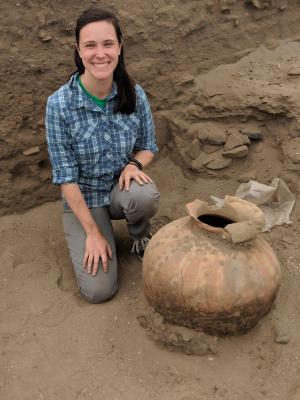
Specialization:
- California Archaeology, Andean Peru
- Historical Ecology, Coastal and Island Adaptations
- Environmental Archaeology, Coupled Human-Natural Systems
- Zooarchaeology, Paleoethnobotany
Education:
Pursuing Ph.D. in Anthropology, University of California, Santa Barbara
2017 M.A. in Anthropology, University of Maryland, College Park
2007 B.A. in Anthropology, Mercyhurst University
Research:
I am an environmental/social archaeologist dually interested in culture contact, foodways, human-environmental interactions, domestication and subsistence strategies. For my research, I examine faunal remains from a range of sites to examine a variety of issues including shifting diets and foodways in culture contact settings, the overhunting of deer populations at Mississippian sites, the domestication of camelids in the Andes.
Projects:
Change, Continuity and Foodways: The Persistence of Indigenous Diet and Identity at Mission Santa Clara
This project focuses on the examination of faunal remains recovered from three middens located next to the Native American barracks at the Spanish mission site of Santa Clara (1777-1836) located in Alta California. Mission Santa Clara contained a diverse population of differing Native American groups including predominantly Ohlone speakers, as well as Yokuts-speaking people, and later in time Miwok individuals. The coming year, this project will incorporate faunal remains recovered from three middens situated alongside the soldier’s quarters. The goal of this study is to assess change and persistence of indigenous foodways. Specifically, the identification of traditional food sources absent from both mission inventories and Spanish soldiers’ quarters may indicate continued indigenous foraging and the persistence of traditional foodways. Mission livestock and agricultural fields were the products of Native American labor; thus, the integration of analyses of faunal remains and mission records will provide shed light on the relationship between indigenous autonomy and Spanish coercion in terms of diet and foodways.
The domestication of camelids and effect on high elevation adaptation
This pilot project examines faunal remains from sites located in the Lake Titicaca basin at elevations ranging from 13,000-15,000’ (4000-4500 meters) dating to pre-domestication and post-domestication of camelids. The Lake Titicaca Basin is thought to be one of the locations of camelid (llama and alpaca) domestication and incipient herding strategies. Currently, the faunal remains from these sites are being analyzed to determine the ratio of deer to camelid, which changes through time with the domestication of camelids. This pilot study will be followed a more in-depth examination camelids based on genetic, isotopic, and metric data to better understanding the timing and circumstances of the of domestication of camelids, and the implications of domestication for human adaptation to high elevation and the emergence of socio-complexity in the Andes.
Publications:
2017 Ruggiero, K.M., Bass, S., Noe, S., Environmental Literacy-Determining the Effects of Politics on Environmental Education Policy in the Unites States. In American Educational Research Journal, in press.
